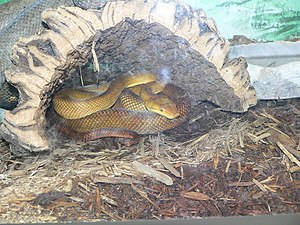Pacific tree boa
| Pacific tree boa | ||||||||||||
|---|---|---|---|---|---|---|---|---|---|---|---|---|

Pacific tree boa ( Candoia bibroni ) |
||||||||||||
| Systematics | ||||||||||||
|
||||||||||||
| Scientific name | ||||||||||||
| Candoia bibroni | ||||||||||||
| ( Duméril & Bibron , 1844) |
The Pacific tree boa ( Candoia bibroni ) is a species of snake from the family of boas (Boidae), where it is in the subfamily of the constrictor snakes classified (Boinae). The Pacific tree boa occurs in two subspecies and inhabits the rainforests and wetlands of Serams , Melanesia, and Polynesia .
features
Pacific tree boas reach an average body length of 1.25 meters, occasionally up to two meters. The head is large, triangular and clearly set off from the neck. The eye is small, the muzzle is beveled, and the front teeth are elongated.
Coloring and drawing vary greatly between different individuals and are also subject to a physiological change in color during the day, with the animals appearing much lighter in color in the morning than in the afternoon and at night. The basic color is brownish with often reddish tinted flanks. Chocolate brown to black spots appear on the back and flanks as a pattern. The top of the head and temples are usually dark with light speckles. The belly side is porcelain-colored with dark spots in the rear area and a narrow light-dark banding on the underside of the tail.
Males have elongated anal spurs that are absent or poorly developed in females.
distribution
The nominate form ( C. bibroni bibroni ) is found on the Fiji , Bank , Loyalty and Society Islands and on Tonga , while the subspecies ( C. bibroni australis ) is found on the Solomon Islands , Seram , Jamna , the Bismarck Archipelago , the island Woodlark , the Santa Cruz Islands and Samoa .
Way of life
The Pacific tree boa colonizes tropical wet and mangrove forests , and occasionally also cultivated areas. It is mainly tree-dwelling and nocturnal. The range of prey is broad and, depending on body size, includes lizards, birds and small mammals such as bats and rodents.
Young animals are born alive in litters of over 20 animals with a length of 30 to 35 centimeters .
swell
- Ludwig Trutnau : Non-poisonous snakes, part 1 . 4th edition. Eugen Ulmer GmbH & Co., Stuttgart 2002, ISBN 3-8001-3223-0 .
Web links
- Candoia bibroni in The Reptile Database
- Candoia bibroni inthe IUCN 2013 Red List of Threatened Species . Listed by: Allison, A., Hamilton, A. & Tallowin, O., 2011. Retrieved January 30, 2014.